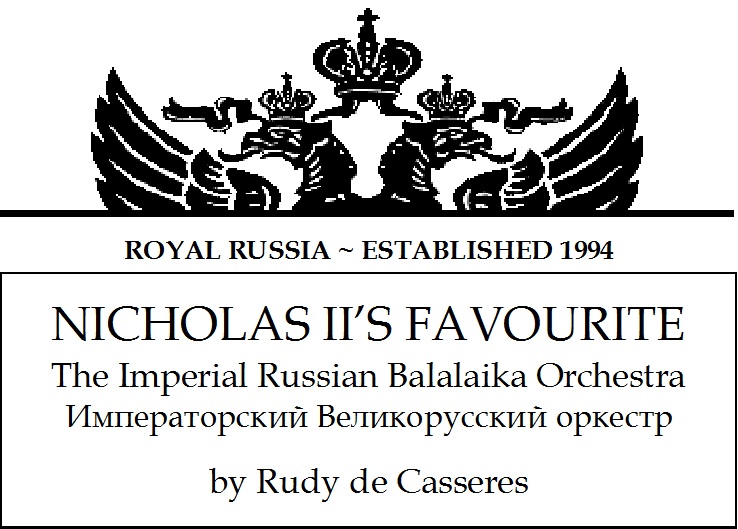 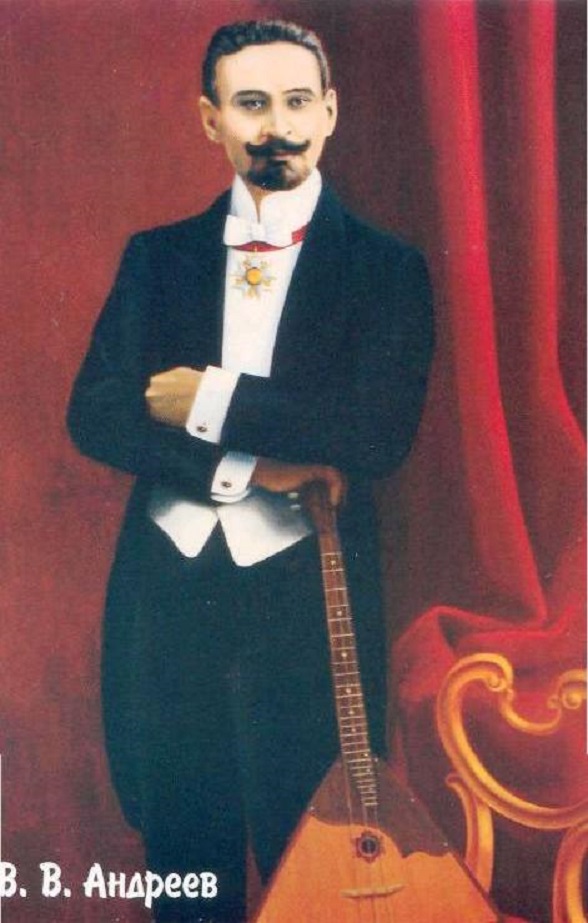 Portrait of Vasily Vasilyevich Andreyev, 1890's Artist Unknown 
|
|
|| Return to Directory
|| Return to Main Page
|| Royal Russia News - Updated Daily || || Royal Russia Bookshop || Join us on Facebook || |
|
In 1888 the orchestra, founded by Vasily Vasilyevich Andreyev, performed for the first time in public. It was then called ”the society of lovers of playing the balalaika’s” (Кружок [Kruzhok] любителей игры на балалайках) and consisted of eight members. The orchestra has grown since then. It survived a revolution, two wars, ”perestroika”, several name changes and still performs regularly, not only in the city of its origin, St. Petersburg, but throughout Russia and abroad as well. Nowadays it’s official name is ”The Andreyev State Academic Russian orchestra”.
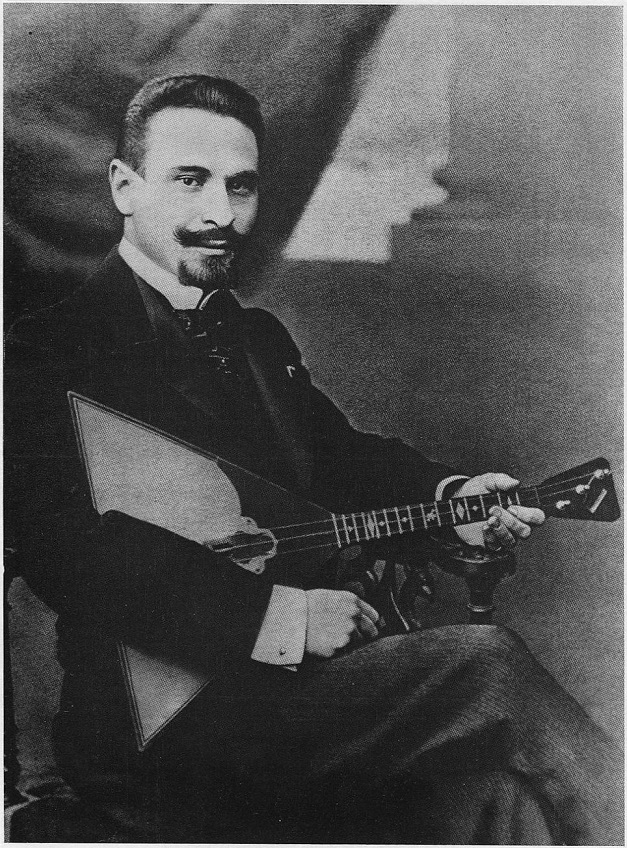 Vasily Andreyev
In 1882, he finished grammar school and traveled through Europe, to Italy. In the summer of 1883 he visited his mother’s manor in Marino (in the Tver province. His mother had bought the manor in 1864) and hears one of the workman, Antip Vasilyev, play the balalaika for the first time. The timbre is so special, he has never heard such an instrument before. Later he will remember: ”I was struck by the rhythm and the original way of playing the balalaika and could not figure out, how such a poor looking, imperfect instrument, with only three strings, could give so many sounds.” Then and there he decided that he wants to play the instrument himself and to improve the balalaika to perfection, to make it a popular instrument, and later, to create a symphonic orchestra based on Russian folk instruments. During the autumn of the following year, when in Bezhetsk he hears Alexander Paskin play the balalaika, and becomes even more convinced of his goal. Paskin was famous in the Tver province for his playing. He gives Andreyev many useful advice. Back in St. Petersburg Andreyev turns to violin maker Vladimir Ivanov, who first declines any involvement, insulted, he insists that ”he only builds musical instruments”. However, Ivanov changes his mind, after he hears Andreyev play, but still insists on keeping his work on the balalaika a secret, fearing for his reputation. Together they start working on improving the instrument: better quality wood is used, the instrument's body is enlarged, its neck is shortened, fixed frets are added. By spring 1886 the first concert balalaika is ready. Initially, Andreyev performs in private salons, but in November and December 1886 he gives his first public concerts. The popularity of the balalaika rises immediately. Court instrument builder Franz Paserbsky contacts Andreyev for cooporation. The balalaika really becomes ”en vogue”. Even the Imperial Family become interested and attend a concert given by Andreyev at Prince Oldenburg’s palace. Now Andreyev gets pupils even from high society.
 GD Xenia Aleksandrovna, GD Aleksander Mikhailovich, their children Irina and Andrei and others playing the balalaika
But still Andreyev and his instrument meet a lot of opposition, contempt and hatred among professional musicians. For example, when he tried to rent a hall for a concert, he was denied a contract when they hear the music will be played on balalaika’s. But on the other hand the number of balalaika-players was on the increase. To be able to form an orchestra Andreyev develops, together with Paserbsky balalaika’s with different diapasons in addition to the balalaika prima: secunda, piccolo, viola, bass and double-bass. In October 1887 Andreyev selected among his best pupils two for every instrument for his orchestra. They start to perform in private circles, playing from memory, as they do not read notes…. By March 1888, they begin the final rehearsals, newspapers are publishing articles on the orchestra, so it is no surprise that the first public concert of the ”Kruzhok” on March 20th in the hall of the St. Peterburg’s Municipal Credit Society is sold out well ahead of time. The profit of this charitable concert goes to the Society for the care of poor and ill children. The public, expecting musicians in traditional Russian costumes, is baffled by the sight of them in impeccable tailored tail-coats, white waist-coats and lacquer shoes. And when the music begins no one is left unmoved. Popular Russian melodies, folk songs, are played in a new way, a new timbre, a new rhythm, on new instruments. Andreyev performs as soloist, director and composer. The success is complete, the public is enthusiastic, so is the press. More is to come, but this first public performance, the acceptance of the balalaika as a concert instrument is a highlight in Andreyev’s career, a realisation of his dreams!
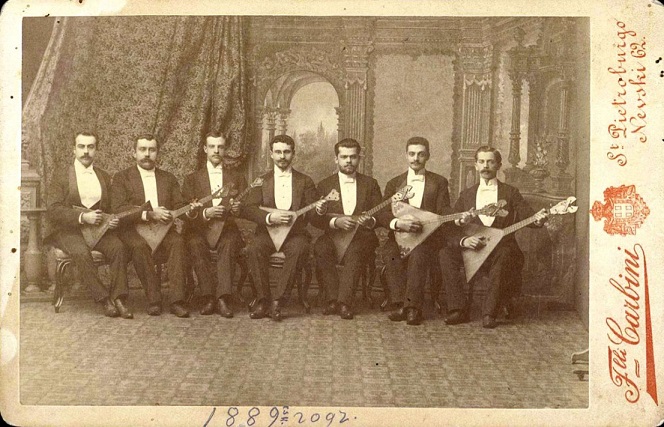 The ”Kruzhok” in 1889 © nlr.ru: Findejzen collection
Back in Russia they tour the country (1889-1891), every where with (in the end) the same success, usually after slow starts, as the public in cities all over Russia also is prejudiced against the balalaika as a concert instrument. The Hall of the Nobility in Moscow is half empty for the first concert, but too small for the second and third concerts. It is typical: the public initially does not approve of the balalaika as an instrument used for classical concerts. But it is quick to change its opinion after hearing the performance of the orchestra. During a performance in Nizhny Novgorod Andreyev makes the acquaintance of Feodor Chaliapin, an acquaintance that is to grow into a great friendship. On one of these tours of Russia Andreyev visits the cultural centre of Talashkino, an estate owned and run by Princess Maria Tenisheva (1858-1928), philanthropist, art collector, artist, who had founded a school of agriculture on her farm in Flyonovo, where agriculture and old Russian culture were combined. Famous Russian artists like Vrubel and Malyutin would later decorate balalaika’s in Talashkino to be shown in the Russian pavilion at the Paris World Exhibition of 1900. A member of the ”Kruzhok”, Vasily Lidin (Bogdanov-Lidin), later moves to Talashkino to teach others how to play the balalaika.
 Andreyev, Tenisheva, Lidin and pupils of the school of balalaika in Talashkino (from the collection of M. Zolotarev)
In 1892 the ”Kruzhok” travelled to France for the second time, giving concerts in Cherbourg, Le Havre, Rouen, Trouville and Paris, where they also perform for Le Figaro, the newspaper that invited the ”Kruzhok” for this tour. Among the listeners on this trip are composers C. Saint-Saëns, B. Godard, R. Pugnot and J. Massenet, who was especially taken by their talent and the musical effects. For ”introducing a new element into the music” Andreyev receives the ”Palmes Académiques” from the Beaux-Arts section of the Académie Française.
 Photo 5. The ”Kruzhok” in France, 1892, from ”Le tout-Havre illustré”
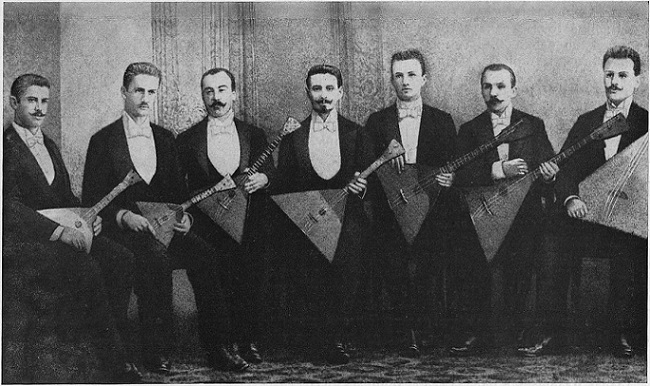 The ”Kruzhok” in 1894, V.V. Andreyev in the middle
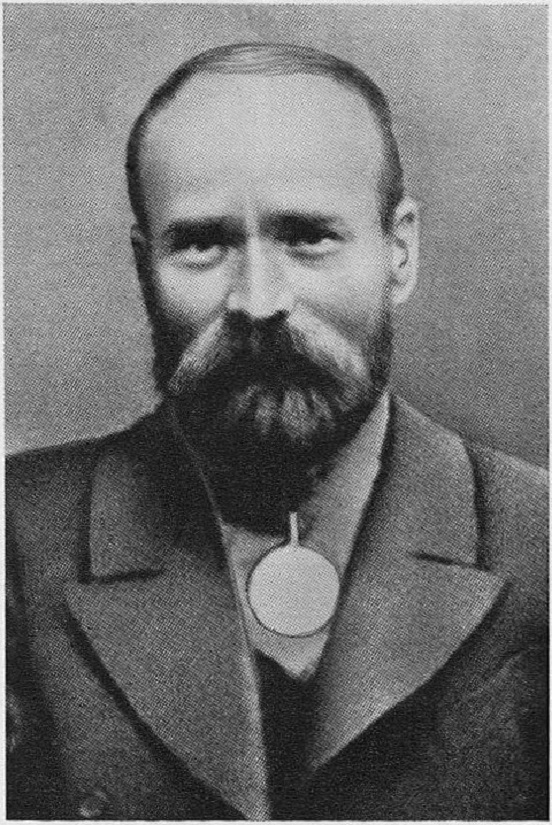 Semyon Ivanovich Nalimov
In 1896 Andreyev and Fomin introduced new instruments in their orchestra: different domra’s, and gusli’s (another multistring instrument). The domra is also a traditional folk string instrument that was improved by Andreyev, Fomin and Nalimov, it corresponds very well with the balalaika and gusli. The domra comes as piccolo, prima, alto and bass, later are added the tenor and contrabass domra’s. With the introduction of new instruments the ”Kruzhok” is no longer an ensemble of only balalaika players, its name is changed into ”Великорусский оркестр”, the Great-Russian orchestra. At the orchestra’s 10-year celebration Andreyev receives the Order of Saint Stanislaus (3rd class). Under the patronage of Emperor Nicholas II the orchestra (24 musicians and Andreyev as director) leaves for a third time to France, for the World Exhibition in Paris of 1900 and performs 25 times in 6 weeks. On this tour Andreyev is awarded the Grand Cross of the Legion of Honour and the Golden Medal of the World Exhibition. However, Andreyev admits, that this Golden Medal should have been given to Nalimov, who received ”only” the bronze medal for his instruments, shown in the Russian pavilion. The orchestra also performs for the French president E. Loubet. Chaliapin, who happens to be in the French capital, takes part in several concerts, including one given by Princess Tenisheva, whose husband was the head of the Russian section at the World Exhibition.
 Andreyev’s orchestra in front of the Russian pavilion at the World Exhibition in Paris, 1900
 ”Orchidea”, a waltz by Vasily Andreev, 1902. Editions Zimmerman
 Balalaika № 102, made by Semyon Nalimov for Vasily Andreyev. Source: St. Petersburg State Museum of Theatre and Music, Sheremetev Palace - Museum of Music
 The orchestra, beginning 20th century
Among the public that evening, Emperor Nicholas II and his family, many State Duma deputies and, of course, Feodor Chaliapin who tells Andreyev: ”You have warmed at your kind, warm heart the orphan balalaika. Through your care and love, she grew up into a wonderful Russian beauty, that conquered the whole world with its beauty” In these high spirits Andreyev turns to the State Duma in an attempt to receive a subsidy for his orchestra and thus secure its existence. But he miscalculated, the Duma is (surprisingly) not willing to support his orchestra. Under pressure from both the press and the musical society, and the benevolence of Nicholas II, the orchestra receives the title ”Imperial” and Andreyev ”Soloist of His Majesty”, thus the orchestra’s future is saved.
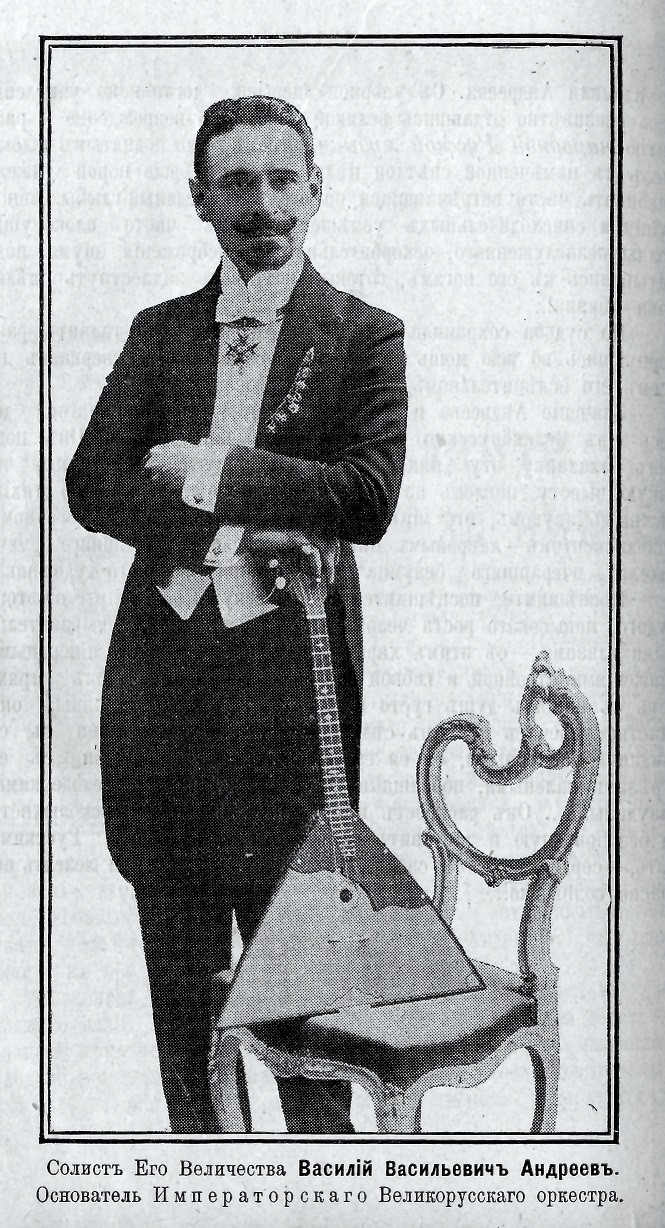 Soloist of His Majesty Vasily Vasilyevich Andreyev. Founder of the Imperial Great-Russian orchestra
 Announcement of concert of Andreyev’s orchestra on January 11, 1916, with all profit to be handed over to Empress Alexandra Fedorovna for charitable use. ”Novoe Vremya, Jan 8, 1916”
 Vasily Vasilyevich Andreyev (1861-1918)
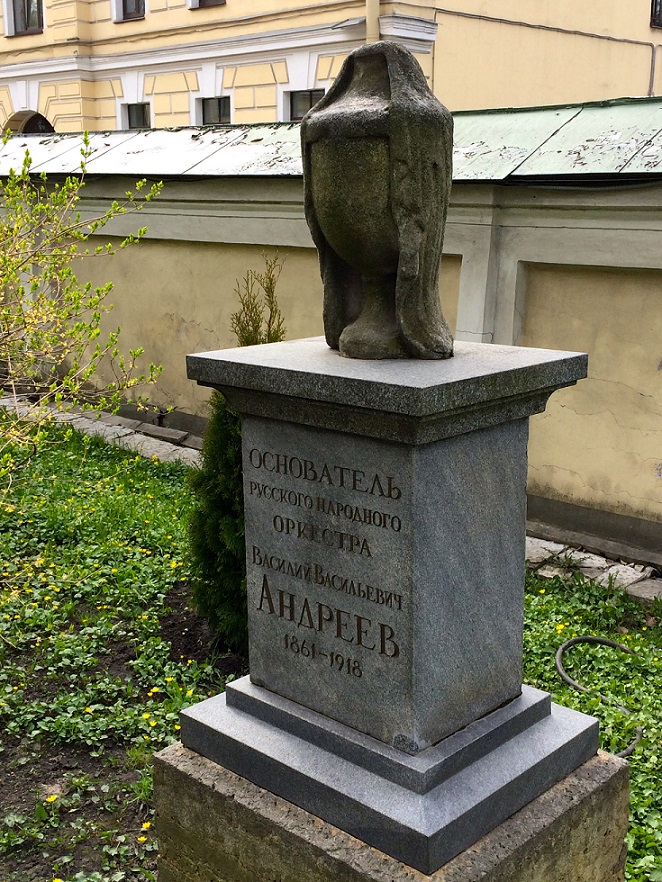 Andreyev’s grave
In 1936 Andreyev is reburied in the newly formed Necropolis of Masters of Art. It will take another 14 years before a monument is placed on the grave: a rectangular postament, on top a marble urn with drapery. On the frontside of the postament is engraved: Founder of the Russian Folk orchestra Vasily Vasilyevich Andreyev 1861-1918. (Originally were engraved the dates 1862-1918, but the text was deleted and the postament turned around, engraved is now the correct year of birth). In January 1995 the monument was damaged after a tree next to the grave is felled, but it is quickly repaired. In 1953 it was decided that Andreyev would be honoured by having his picture on a stamp. A project is made. But Stalin’s death that year and the order that forbade all ”light” topics on stamps canceled the realisation of this project.
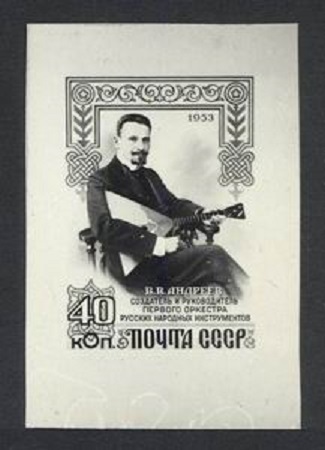 A project for a stamp with Andreyev
In 1988, 100 years after Andreyev’s ”Kruzhok” first public performance another plaquette was unveiled on the wall of the building where this concert had taken place: the former St. Peterburg’s Municipal Credit Society, today it houses the Bank Saint Petersburg (Ostrovsky Sq. 7)
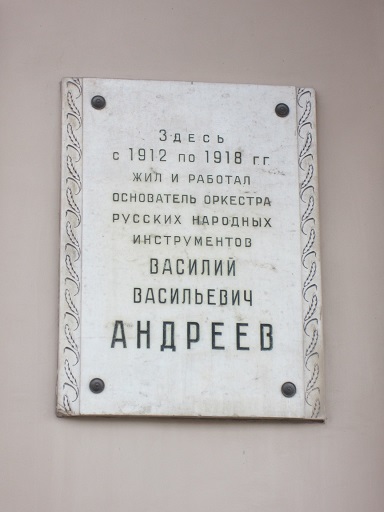  Memorial plaquettes in St. Petersburg
After Andreyev’s death the orchestra goes on performing (although, not without difficulties, as no subsidy was paid anymore), first under Nikolai Fomin and from 1920 till 1933 under Fedor Niman. In May 1921 the orchestra at last receives state recognition and subsidy and is now called after its founder, the State Russian Andreyev Orchestra. However, following a number of state reforms, the orchestra again looses its funding the following year. Nevertheless, the collective stays together and keeps on performing, thanks to the inspiring enthusiasm and organisation abilities of Fedor Niman. Following the example of Andreyev, attempts to popularise the balalaika are intensified: many musicians of the orchestra start to teach the balalaika and form small groups in factories, companies, schools etc. For example, in 1926 out of 50 orchestra members 21 direct ensembles. In Leningrad alone more that 150 such collectives had been formed. Small ensembles of folk instruments were performing in theaters, cinemas, and restaurants. Some of them began using the name of Andreyev, but this is soon forbidden. All over the Soviet Union, and later in Russia (and not only) thousands of classes, groups, small and larger orchestra’s, of folk instruments are formed and began performing. At last, the dream of Andreyev had become a reality. In October 1938 the orchestra’s fiftieth anniversary is celebrated with a jubilee concert at the Leningrad State Philharmonia. This year the orchestra performs in factories, workers’ clubs, for sailors and tours the country: 5 republics, 27 cities. ”Half a century jubilee of this collective - a feast of all musical art of the great Soviet country”. The years 1938-1941 are mainly spent on tour through the Soviet Union, enjoying success everywhere, but by playing everywhere the same program, the artistic development of the orchestra suffers. The orchestra returns from a tour to the Russian far east on the eve of a new war. In the black days of autumn 1941 the orchestra is dissolved, but members, in a patriotic mood, decide to stay together and organize concerts in Leningrad under siege, under the inspiring direction of Karl Eliasberg. But the orchestra also suffers, its ranks diminishes, but smaller groups keep on performing in hospitals and at the front. Of the 40 members from the beginning of the war now only 12 are left, and they continue their concerts. Spring 1942, in order to raise the mood of the people in a city suffering under siege, musical forces are activated. A new orchestra is formed, with musicians from both the Andreyev and the Leningrad Radio orchestras: the orchestra of folk instruments (ОНИ: Оркестр народных инструментов). They begin with only 6 musicians, soon the orchestra has 20 members, and is able to give concerts, for example, 90 in 1943. Directors over these years are N. Mikhailov, N. Vasilyev, E. Grikurov, N. Selitsky and S. Yeltsin. In 1951 Andreyev’s name returns, as the orchestra is now officially called: the ”Andreyev orchestra of folk instruments of the Leningrad Radiocommittee”. The orchestra now performs both in (radio)studios and concert halls, as well as in factories as it did before the war. The famous conductor, Leopold Stokowski, asks and is allowed to direct the Andreyev orchestra during his visit in Leningrad on June 25th, 1958 and witnesses: ”An unforgettable experience”. Concerts and events to celebrate the 100th anniversary of Andreyev become a great feast of Russian folk instruments and culture. In 1961 the orchestra again receives a new name: the Russian folk orchestra named V.V. Andreev (Русский народный оркестр имени В.В. Андреева). To improve the tone-coloristic and dynamic possibilities of the orchestra new (wind- and percussion) instruments are introduced, as is the ”bayan” (Russian chromatic accordion), making it possible for the orchestra to perform works by young local composers, like B. Kravchenko, Yu. Zaritsky, G. Belov, L. Balai and N. Shakhmatov. In May 1978 the Andreyev orchestra returns to Le Havre, where it had performed before, in 1892. (See Photo 5) A new chapter in the history of the Andreyev orchestra was being written by the appointment in 1986 of a new director, Dmitry Khokhlov. Under his enthusiastic and experienced guidance the orchestra began rising to new heights, extending their repertoire with works by young, rising, composers, performing with young solists, both vocal and instrumental, sometimes on unexpected, but exciting instruments, like saxophone and nai flute. The mastership of the orchestra’s musicians was shown, when they were (often) performing themselves as solists. The orchestra today is very much alive and performing successfully, in the spirit of its founder, Vasily Vasilyevich Andreev.
 The Andreyev State Academic Russian Orchestra, today
”Let’s follow him …." ”If you do not know Andreyev, if you have not visited his Russian orchestra’s concerts, - if your soul has not died down together with the chords, now voiceless sobbing, then impetuous bursting onto the wide expanse of the Russian steppes, into the distance, into the sky, - if tears of joy have not filled your eyes at these sounds, melodies and songs, so familiar, vital, touching the deepest secrecies of your heart, - if you do not know Andreyev, hurry to him, let’s follow him!.... The Balalaika, - a no-good, ”three-string”! Is it worth talking about!! That’s how ten-twenty years ago shallow-hearted, dry sceptics grumbled, when Vasily Vasilyevich started to wake up people’s hearts with his melodic play. But the superior sneers, plain witticism, cheap irony of the gentlemen-”authorities” did not break Andreyev. With persistent energy, worth astonishment, unselfishly devoting himself to the great job of reviving and developing Russian folk music, he strides head high to a selected bright aim… And how difficult at times it was to crush the icy blocks of indifference and haughty sneers he so often met on his path! How often boiling waves of undeserved, insulting disdain came noisily rolling to his feet, almost ready to sweep away this daredevil - of the bayan (Russian accordeon)!… But fate saved Andreyev for Russia. His talent, unfolding its mighty power, now sparkles in all its dazzling, glamorous splendor. The importance of Andreyev and his famous, known all over the world, Russian orchestra is extremely great. He lifted the balalaika, this ”no-good three-string thing” to such a height, extracted from its womb such a clear, vivid power of sweet sounds, that the world gasped and with an overwhelming thunder of applause - a laureate wreath awarded this ”yesterday’s dreamer, madman”, today’s great artist. Hurry, hurry to Andreyev. Look at this lean man of middle height, with lustrous, eloquent eyes, - with this charateristic dry face and nervous movements of his slim and slender body. Hurry, - he will sweep the thick settled dust of commonness from our souls, he will direct us into the grey good old days of Russian life … He will expose to you the Russian soul, stir her restlessness and he will force you to be, if only for half an hour, Russian, - to love with all your heart Holy Russia and to cherish her, beautiful sweetheart!… We transcribe the family name Андреев as Andreyev, as is done for ex. by the Andreyev orchestra’s official site in English. It comes as well closest to the Russian pronunciation of the name (three syllables). Pictures Unless mentioned otherwise, pictures come from the public domain, www.andreyev-orchestra.ru and the private collections of the author. With special thanks to Natalia Mitina, director of the Andreyev State Academic Russian orchestra, Olga Velikanova, Chief of Branch, St. Petersburg State Museum of Theatre and Music, Sheremetev Palace - Museum of Music, Alexei Alexeev, head of the Manuscripts Department of the National Library of Russia, all in St. Petersburg, and Paul Gilbert, Founder of Royal Russia (Est. 1994) for their cooperation.
|


